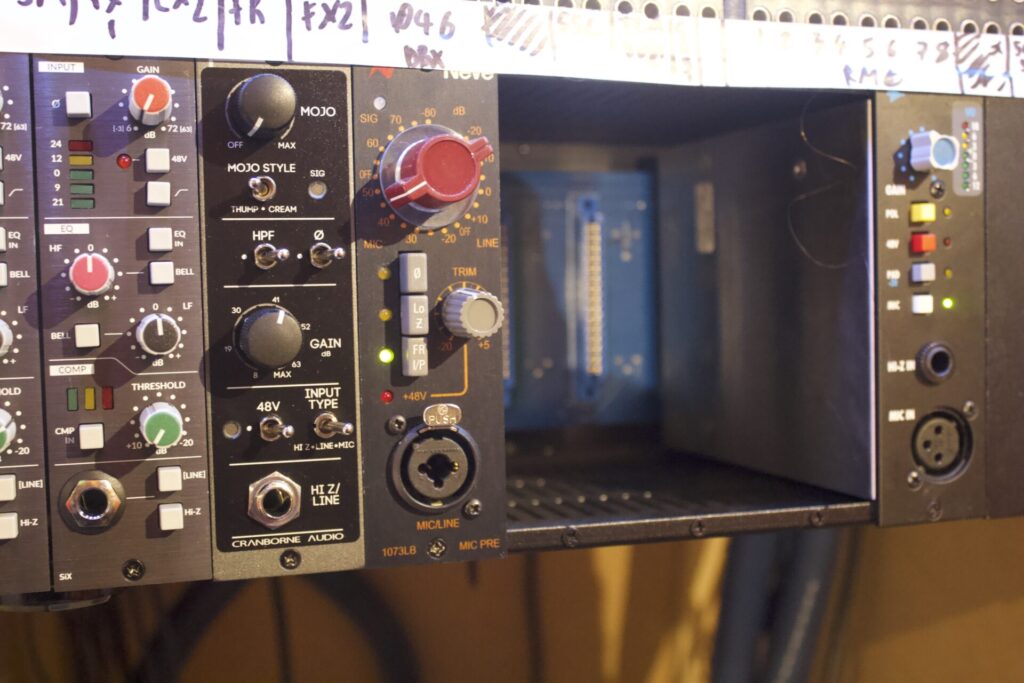10th December 2024
Introduction
I thought it would be fun and interesting to compare some 500 series units that I recently bought in a preamp shootout to get a feel for how they sound in different situations. It has actually given me a great insight into what can work for what situation!
A mic pre is the part of the audio hardware that converts the mic signal from mic level to line level. In this case I am comparing various outboard 500 series XLR mic pres by Neve, API, SSL and Cranbourne as well as the built in XLR mic pres on my RME audio interface.

This preamp shootout is just concerning electric guitars but I intend to try different sources in future blog posts.
Method
I recorded a DI guitar sound into the computer which I then played back through an amp and recorded into the different mic pres.
This way I could ensure the performance was the same for each mic pre. I set the level so the peak was exactly the same in the DAW for each mic pre. This method does not of course mean that the same amount of drive/warmth/crunch would be present for each sample because the different pres will be non-linear in different ways. This will however give us an insight to the basic character of the preamps.
Results
Listen to the preamp shootout video with headphones or good quality speakers as the differences are quite small indeed. As we know though theses small changes stack up quickly in a production.
I’d love to know what you think about the differences! Let me know in the Youtube comments 🙂
Preamp Shootout Conclusions
I made a separate video for my opinions on clean guitar and dirty guitar because, well…..I’m a guitarist. The video has a more in depth explanation but below there is a very brief summary:
Dirty guitar chords – Just a standard power chord motif here
- SSL / API. It’s a tie. The SSL has a lot more bite to it, great for aggressive punk or garage sounds where the API is more smoothed out in the upper mids and thicker.
- Neve / Cranbourne. The Neve has a more pronounced mid range which doesn’t seem to work as well for this kind of sound….it’s almost like it’s too polite for the occasion. The Cranbourne has a nice roundness to it which is pleasing on the ears but I prefer the aggression of the fist place.
- The RME is ‘meant to be’ a decent pre amp but compared to all of these it’s actually rubbish.
Overdriven guitar riff – I suppose I’m going for a punchy pentatonic ‘Hendrixian’ type riff around the 7-9th fret on the lower strings
- Neve. It just had a much more articulate mid range which was great for riffs to make them more punchy in the chest area…more twang.
- Cranbourne Camden. Not as clear as the Neve but had a nice round glassy tone which sounded good for this sound
- SSL. Definitely less fat than both of the above.
- API. A lot more ‘blocky’ and slow on the attack. Might be good for more sludgy tones but the saturation doesn’t work for this
- RME. Sorry lost again!
Clean guitar – A picking, arpeggionic riff with a glassy clean tone
- Neve, Has an expressive mid range, clearer, more sparkly which is great for this tone
- Cranbourne. It has a subtle warmth to it which is pleasing
- SSL. It sounds a bit too thin and ‘spiky’ to me!
- API. Too muddy especially on the low strings
- RME. No, just no.
To sum up…..
Preamps from audio interfaces are terrible compared to these higher end ones. In recordings, these things layer up to make a much bigger effect….the first time I recorded some drums with these APIs the effect was immense. What seems like a tiny difference actually makes a big change when it’s all over the production.
I was surprised how actually the ‘budget’ pre’s held up, in some case winning against the studio classics. It just goes to show you that it’s worth taking time to do these comparisons to get to know your gear in detail and find out what can be used for what!
